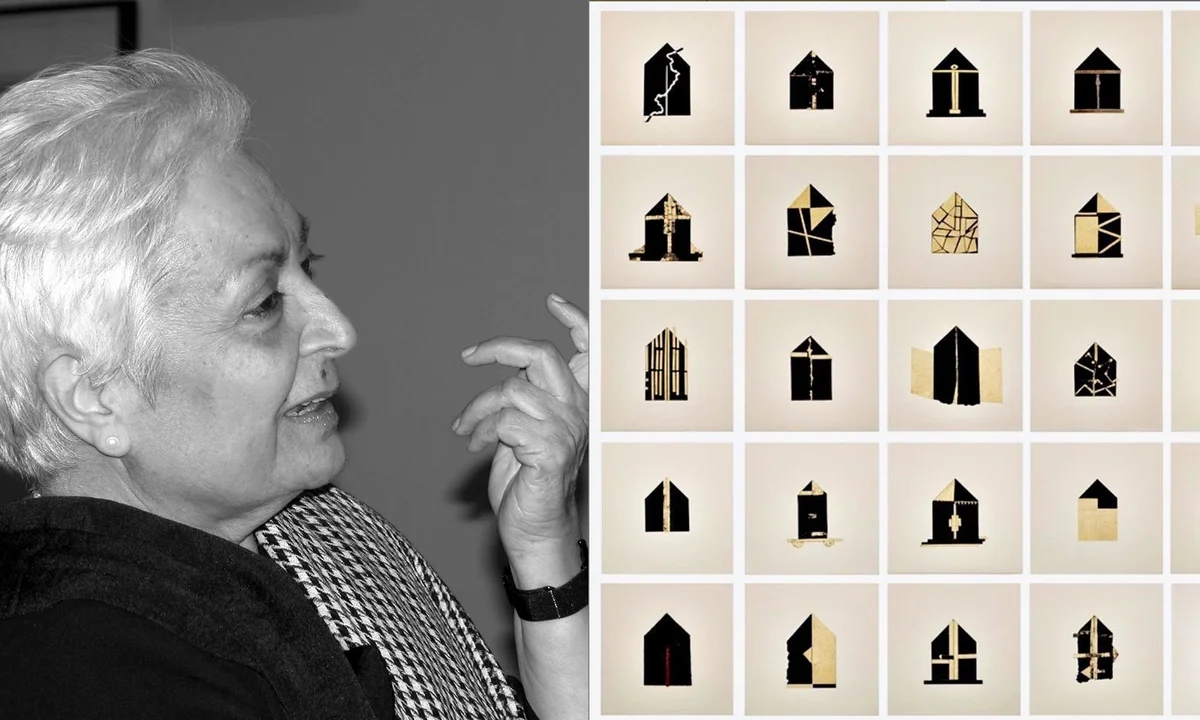Zarina Hashmi, born in Aligarh, India, in 1937, was an Indian-American artist and printmaker whose creative journey came to a close on April 25, 2020. Her artistic legacy is marked by a dedication to minimalism and printmaking, with a consistent exploration of themes like the concept of home, displacement, borders, journeys, and memories.
Foundation of Zarina Hashmi Distinctive Body of Work:
Zarina’s passion for architecture and mathematics left a profound imprint on her artistry, evident in her meticulous use of geometric forms and a strong focus on structural purity. While her work leans towards minimalism, it balances this starkness with a rich texture and materiality that add depth to her creations. Utilizing various printmaking techniques, including woodblocks, lithography, and silkscreen, Zarina hashmi honed her craft through formal training in woodblock printing in Bangkok and Tokyo, following her earlier academic pursuits in mathematics. Additionally, she furthered her skills in intaglio under the guidance of S. W. Hayter at Atelier-17 in Paris. These diverse experiences and her personal life experiences serve as the foundation for Zarina’s distinctive body of work.
Zarina’s art serves as a poignant chronicle of her life, consistently delving into the themes of home, displacement, borders, journeys, and memories. Her creations have found their rightful place in renowned international institutions such as the MoMA, the Whitney, and the Metropolitan Museums in New York, cementing her status as a celebrated and influential artist.
Exploring Printmaking The Artistic Journey of Zarina Hashmi
Zarina’s Introduction to Printmaking
Pioneering Printmakers: Discovering Ancient Artistic Techniques
Printmaking is a type of visual art in which pictures are created using a variety of multiplication processes, generally on paper but occasionally on cloth, plastic, or another substrate, with the help of or by the artist. The Sumerians (c. 3000 BCE), who carved artwork and cuneiform writings on cylinder seals (often made of stone), used this method to duplicate pictures on soft clay tablets.
Printmakers have developed into an artistic medium that is entwined with ink and creativity through the course of centuries of cultural impact and creative invention. The earliest printing artifacts are from China and Egypt’s prehistoric eras. Printmaking was first used to distribute copies of various religious manuscripts and texts. With time, it began to change from being used for preservation to producing various works of art, and it also had a significant impact on the printing process.
The Power of Reproduction: Printmaking’s Impact on Visual Culture
Minimalism, an art movement that took root in the United States during the 1960s, is distinguished by its commitment to simplicity, clarity, and the deliberate reduction of form. Artists aligned with minimalism aimed to craft pieces that were distilled to their most fundamental components, free from any unnecessary embellishments or intricate details. This artistic movement emerged in direct response to the prevailing dominance of Abstract Expressionism, which was characterized by its emotional intensity and expressiveness within the art world of that era.
Minimalist art frequently aligns with attributes such as geometric abstraction, monochromatic color palettes, and the utilization of industrial materials like steel and concrete. The primary goal of this movement is to underscore simplicity and the paring down of forms, all to foster a sensation of order and lucidity. By doing so, minimalist art encourages viewers to partake in a reflective and contemplative encounter with the artwork.
Zarina Hashmi’s Minimalist Approach:
Zarina Hashmi was an acclaimed Indian American artist and printmaker whose work left a profound impact on the art world. Born on July 16, 1937, and based in New York City, Zarina’s artistic journey encompassed drawing, printmaking, and sculpture. As a prominent figure associated with the minimalist movement, her unique artistic approach utilized abstract and geometric forms to evoke a spiritual response from viewers.
Zarina used abstract and geometric forms to evoke a sense of serenity and transcendence via her minimalist style. Her paintings frequently used lines, geometric forms, and repeating patterns that prompted viewers to reflect. She created things that enabled the spiritual core to come through by removing superfluous features.
The Impact of Minimalism on Zarina Hashmi’s Work:
Zarina Hashmi’s artworks were imbued with themes of home, memory, and the longing for a sense of belonging. These ideas struck a powerful chord with her own story, since she had experienced displacement all of her life. Her prints sometimes included plans for buildings, maps, or abstract images of houses, alluding to the common need for security, roots, and a place to call one’s own.
She was able to elicit a profoundly spiritual response from viewers because of her minimalist style and inventive use of abstract and geometric elements. Zarina’s artwork focused on the shared human experience by examining topics like home, memory, and belonging.
Zarina Hashmi Artistic Odyssey: Exploring Printmaking Techniques
Zarina studied a variety of printmaking methods in Thailand, Paris, and Tokyo. Her woodblock prints are characterized by their simplicity and minimalism. For instance, the woodblock print “Paper Like Skin” by the artist shows a thin black line wandering upward over a white backdrop, dividing the page from the bottom right corner to the top left corner. The line possesses a cartographic quality that suggests a border between two places or perhaps a topographical chart of a journey that is yet unfinished.
Zarina’s Minimalist Art Techniques:
Zarina’s art was informed by her identity as a Muslim-born Indian woman as well as a lifetime spent traveling from place to place. She used visual elements from Islamic religious decoration, especially the regular geometry commonly found in Islamic architecture. The abstract and spare geometric style of her early works has been compared to that of minimalists such as Sol LeWitt. Zarina’s work explored the concept of home as a fluid, abstract space that transcends physicality or location. Her work often featured symbols that called to mind such ideas as movement, diaspora, and exile.
Combining Printmaking and Minimalism:
Zarina’s work often combined printmaking techniques with minimalist art techniques. For example, her woodcut print based on an engraving of the city of Shajahanabad as it stood before the siege of 1857 is an excellent example of how she combined these two techniques. The print features geometric shapes and patterns that are reminiscent of Islamic architecture while also incorporating elements of printmaking such as lines and textures.
Understanding Minimalism and Printmaking:
Minimalism is a style of art that emerged in the early 1960s. It is characterized by the use of simple geometric shapes, monochromatic colors, and a focus on the materiality of the artwork. Printmaking is a technique used to create multiple copies of an image or design.
How to Explore Zarina Hashmi Artwork
Zarina Hashmi was an Indian-American artist known for her minimalist prints and sculptures. To explore her artwork, you can start by visiting her official website. There, you can find information about her life and work, as well as images of her prints and sculptures. You can also visit past exhibitions that showcased her artwork.
Legacy and Future of Zarina’s Art:
Zarina Hashmi’s minimalist artwork has left an indelible mark on the art world. Her prints and sculptures often explored themes of memory, place, and loss. Her work has been exhibited in major international institutions such as MoMA, the Whitney Museum of American Art, and the Metropolitan Museum of Art in New York.






Leave a Reply